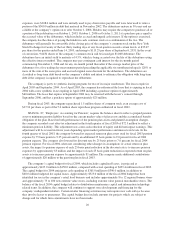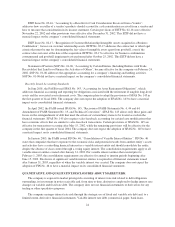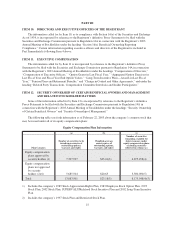Albertsons 2003 Annual Report Download - page 23
Download and view the complete annual report
Please find page 23 of the 2003 Albertsons annual report below. You can navigate through the pages in the report by either clicking on the pages listed below, or by using the keyword search tool below to find specific information within the annual report.reporting units were tested for impairment by comparing the fair value of the respective reporting unit with its
carrying value. Fair value was determined primarily based on valuation studies performed by the company,
which considered the discounted cash flow method consistent with the company’s valuation guidelines. The
company performed the second annual impairment test as of December 28, 2002 using the same methodology
described above. As a result of impairment tests performed, the company recorded no impairment loss.
In August 2001, the FASB issued SFAS No. 144, “Accounting for Impairment or Disposal of Long-Lived
Assets”. The company adopted the provisions of SFAS No. 144 effective February 24, 2002. SFAS No. 144 did
not have a material impact on the company’s consolidated financial statements.
In June 2002, the FASB issued SFAS No. 146, “Accounting for Costs Associated with Exit or Disposal
Activities”. SFAS No. 146 addresses financial accounting and reporting for costs associated with exit or disposal
activities and nullifies Emerging Issues Task Force (EITF) Issue No. 94-3, “Liability Recognition for Certain
Employee Termination Benefits and Other Costs to Exit an Activity (including Certain Costs Incurred in a
Restructuring)”. SFAS No. 146 requires recognition of a liability for the costs associated with an exit or disposal
activity when the liability is incurred, as opposed to when the entity commits to an exit plan as required under
EITF Issue 94-3. SFAS No. 146 was effective for exit or disposal activities initiated after December 31, 2002.
The company did not initiate any new exit or disposal activities subsequent to December 31, 2002. Accordingly
SFAS No. 146 did not have a material impact on the company’s consolidated financial statements.
In December 2002, the FASB issued SFAS No. 148, “Accounting for Stock-Based Compensation—
Transition and Disclosure”. SFAS No. 148 amends SFAS No. 123, “Accounting for Stock-Based Compensation”
to provide alternative methods of transition for a voluntary change to the fair value based method of accounting
for stock-based employee compensation. SFAS No. 148 also amends the disclosure requirements of SFAS
No. 123 to require additional disclosure in both annual and interim financial statements on the method of
accounting for stock-based employee compensation. The company adopted the disclosure provisions of SFAS
No. 148 in the fourth quarter of fiscal 2003.
In November 2002, the FASB issued Interpretation (FIN) No. 45, “Guarantor’s Accounting and Disclosure
Requirements for Guarantees, Including Indirect Guarantees of Indebtedness of Others”. FIN No. 45 requires
companies to recognize, at the inception of a guarantee, a liability for the fair value of the obligation undertaken
in issuing the guarantee. Guarantees in existence at December 31, 2002 are grandfathered for the purposes of
recognition and would only need to be disclosed. The company adopted the initial recognition and measurement
provisions of FIN No. 45 for guarantees issued or modified after December 31, 2002. FIN No. 45 did not have a
material impact on the company’s consolidated financial statements.
EITF Issue No. 01-09, “Accounting for Consideration Given by a Vendor to a Customer (Including a
Reseller of a Vendor’s Products)”, which codified EITF Issue No. 00-14, “Accounting for Certain Sales
Incentives”; EITF Issue No. 00-22, “Accounting for ‘Points’ and Certain Other Time-Based or Volume-Based
Sales and Incentive Offers, and Offers for Free Products or Services to be Delivered in the Future”; and EITF
Issue No. 00-25, “Vendor Income Statement Characterization of Consideration Paid to a Reseller of the Vendor’s
Products”, became effective for the company on February 24, 2002. These issues address the appropriate
accounting for certain vendor contracts and loyalty programs. This EITF did not have a material impact on the
company’s consolidated financial statements.
EITF Issue No. 02-13, “Deferred Income Tax Considerations in Applying the Goodwill Impairment Test in
FASB Statement No. 142, ‘Goodwill and Other Intangible Assets’ ”, requires that deferred income taxes be
included in the carrying amount of a reporting unit for the purposes of the first step of the SFAS No. 142
goodwill impairment test. EITF No. 02-13 is effective for goodwill impairment tests performed after
September 12, 2002. The company adopted the provisions of EITF No. 02-13 for the goodwill impairment tests
performed in the fourth quarter of fiscal 2003. This EITF did not have a material impact on the company’s
consolidated financial statements.
23
























